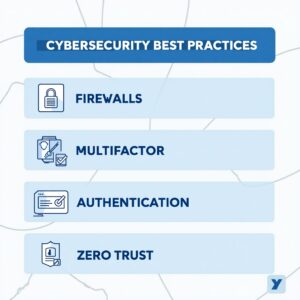Cybersecurity is facing a wake-up call. A zero-day vulnerability in Microsoft SharePoint has just allowed a Chinese-linked cybercriminal group to infiltrate none other than the U.S. National Nuclear Security Administration-along with 400+ other global organisations. Let that sink in: the agency responsible for maintaining America’s nuclear arsenal was accessed by attackers armed not with missiles, but with stolen authentication keys. If you work in cybersecurity, this hits different. It’s not just a headline—it’s a signal. A warning. Proof that even highly fortified networks aren’t bulletproof.
So, what exactly happened? How did attackers get in? And what does this mean for you, your team, and your cybersecurity posture moving forward?
Let’s break it down.
The Breach That Shook the Cybersecurity World

In July 2025, Microsoft confirmed that a sophisticated cyberattack had been launched using a previously unknown (zero-day) vulnerability in its SharePoint servers. The exploit was linked to a state-sponsored group from China, who used stolen authentication keys to bypass identity protections and infiltrate critical systems.
Among the affected: the U.S. Department of Energy, various nuclear labs, and global financial institutions. It was one of the largest, most strategic, and most troubling cybersecurity breaches of the year.
What makes this breach so important in cybersecurity circles isn’t just the number of victims—it’s the nature of the access. Attackers didn’t just get in. They got in silently and with trust-level access.
also read: AI vs AI – How artificial intelligence is reshaping the cybersecurity battlefield in 2025
What Are Zero-Day Vulnerabilities in Cybersecurity?

In cybersecurity, a zero-day vulnerability is a flaw in software that’s unknown to the vendor and has no patch available yet. That means attackers can exploit it before any security teams know it even exists.
These vulnerabilities are gold for nation-state actors. And in this breach, the Microsoft SharePoint zero-day gave them a backdoor into systems that most people would assume are impenetrable.
For cybersecurity teams, this is the nightmare scenario:
- No alerts
- No malware signatures
- No known threat actor patterns to detect
The only protection against zero-day attacks is layered, adaptive cybersecurity strategy, not just software updates.
also read: Cybersecurity alert: Citrix bleed 2 is the latest critical threat
Stolen Authentication Keys: The Silent Saboteur

One of the most chilling details in this attack is the use of stolen authentication keys. In cybersecurity, these keys act like VIP access badges. If you steal one, you can walk straight past all the usual barriers, undetected. That’s exactly what happened here. Attackers used these keys to spoof legitimate user access. They didn’t brute-force passwords. They didn’t need phishing emails. They just walked in quietly. This breach is now being studied across the cybersecurity community as a perfect example of how identity-based attacks are escalating faster than traditional perimeter breaches.
The Fallout: Impact on U.S. Nuclear and Global Infrastructure

Let’s be clear: no classified data has been confirmed stolen yet. But the implications are still serious. The U.S. National Nuclear Security Administration manages nuclear warheads and strategic deterrents. The very fact that an adversarial nation could access these systems is causing alarm across global cybersecurity watchdogs. Other victims include defence contractors, global financial services, and cloud infrastructure partners.
In short: if you use Microsoft services, you were potentially at risk.
What This Means for Microsoft SharePoint and Cybersecurity Trust
Microsoft SharePoint is used by millions of enterprises. It’s a core collaboration tool that touches files, emails, permissions, and document workflows.
But this breach raises big cybersecurity questions:
- How do you trust a platform that can be hijacked from the inside?
- Is your patching policy enough?
- Are you using conditional access, MFA, and identity segmentation effectively?
The cybersecurity lesson is You can’t rely on vendor security alone. You need visibility into identity behaviours, not just endpoint events.
also read: AI risk summit 2025
Urgent Cybersecurity Lessons You Need to Act On

Here’s what this incident teaches us, loud and clear:
- Zero Trust isn’t optional anymore: If you’re still running with perimeter-based security, you’re living in the past. Identity must now be the new perimeter in cybersecurity.
- Credential Theft is the real battlefield: Most modern breaches don’t start with malware; they start with stolen tokens. Invest in behavioural analytics, token monitoring, and identity protection.
- Don’t skip patching—But don’t rely on it: Yes, patch your systems. But also test those patches. And assume attackers already know your blind spots. Cybersecurity isn’t one-and-done.
- Educate everyone, not just IT: This breach wasn’t caused by user error, but preventing lateral movement depends on well-trained people, from HR to C-Suite.
- Monitor for Unusual Authentication: If you’re not watching for things like “logins from unexpected geographies” or “privilege escalation anomalies,” you’re flying blind.
Conclusion

This breach wasn’t just another hack. It was a global cybersecurity alarm bell that proves even the most well-resourced agencies can be vulnerable. As cybersecurity professionals, this is our challenge—and our call to action. Stay vigilant. Build smarter defences. Challenge assumptions. And never stop sharpening your skills. If you’re passionate about cybersecurity, whether you’re an ethical hacker, student, or junior analyst—now is your moment. This breach is a textbook case of why your work matters.
“Cybersecurity is no longer just an IT issue—it’s a matter of national resilience. Learn fast. Act faster”
Cybersecurity isn’t just about fixing firewalls or removing viruses. It’s about national security, trust, and resilience. And as systems get smarter, so do the threats. We need new minds, fresh perspectives, and relentless curiosity to stay ahead. Keep reading, keep learning, and keep questioning everything. Visit Digived Academy to learn more about our Cybersecurity Training programs and start your journey as cybersecurity professional today.
Frequently asked Questions (FAQs):
- What is a zero-day vulnerability in cybersecurity?
It’s a software flaw unknown to the vendor with no fix available, making it a prime target for cybercriminals. - How did attackers get into Microsoft SharePoint?
They used a zero-day exploit and stolen authentication keys to bypass identity protections. - What is the cybersecurity risk of stolen keys?
They allow attackers to impersonate legitimate users, giving them deep system access without raising alarms. - Was any nuclear data stolen?
As of now, no confirmed data theft has been reported—but investigation is ongoing. - What can companies do to prevent similar attacks?
Implement zero-trust architecture, monitor identity anomalies, and use strong authentication protocols. - Why is this breach so significant in cybersecurity history?
It involved high-value targets, stealth access, and exposed deep flaws in identity-based defences.
Contact Us
For more information about our courses, schedules, and enrolment process, visit our website or contact us at.
Website: www.digived.academy
Email: admission@digived.academy
Phone: +91-9019299971



